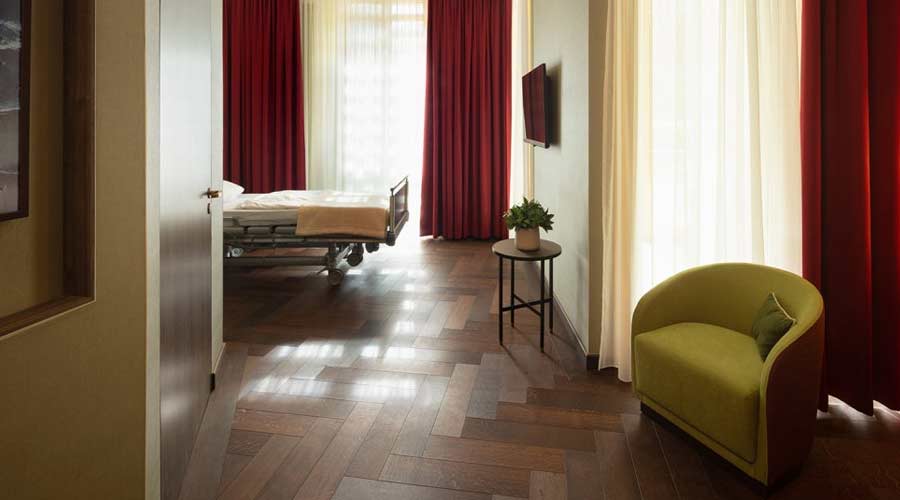Everyone knows the scenario too well: You’re trying to keep quiet in the middle of the night, but that creaky floorboard gives way and makes a sound. In certain scenarios, a noise in the middle of the night isn’t detrimental, but when in hospitals and other healthcare facilities, it can make or break a patients’ stay and recovery.
Flooring is one of the only areas that touches every single person, so the decision-making process of selecting it for use in healthcare facilities is extremely important. Facilities are especially concerned with cleanability, sanitation and durability in high-traffic areas. Facilities managers are responsible for selecting products that can overcome substantial wear and tear and determining whether the price tag is worth it.
“A big part of that wear and tear comes from the cleaning protocols of the facility and is the reason we never recommend a flooring material until we understand those protocols,” says Elizabeth Von Lehe, director of specialty interiors with HDR. “The machinery or chemicals involved can be perfect for one flooring and cause another to quickly fail.”
Different areas of healthcare facilities require different types of flooring. Back-of-house options include more downplayed sheet products, while entrances, lobbies or lounge spaces could use custom terrazzo or even carpet. Flooring allows facilities to be creative in ways that many patients and visitors normally don’t expect. This all ties to the brand, aesthetic expectations of the patient and families and cleaning protocols appropriate for a given space.
“Entrances and corridors will have high-traffic foot loads,” says Rocky Berg, AIA and principal with three, an architecture firm. “Good choices here would be luxury vinyl tile, vinyl composition tile, rubber and sheet vinyl. For procedure rooms, designers tend toward sheet rubber or linoleum because seams can be eliminated, and they are more cushioned than VCT or sheet vinyl. LVT, sheet vinyl, linoleum and carpet are the options here as they allow for extended design opportunities, easy maintenance, as well as quick turnaround times on installation.”
Flooring decisions can greatly impact people’s safety, so it is important to consider slip-resistant options, as well as sterile environments, because such flooring can reduce the spread of bacteria. Employees in hospitals and other healthcare facilities are on their feet for long periods, so managers should considering worker comfort in their specification decisions.
“Flooring decisions can impact safety for both workers and patients in obvious ways, such as tripping or slipping hazards, which are easily avoided by following accepted standards,” Von LeHe says. “The more nuanced side of safety with flooring comes through understanding the needs and nature of the patients receiving care. For aging eyes, some color contrasts can be difficult to see, or for some memory care patients, a high contrast on the floor can be disorienting or frightening. The role of the flooring within the larger design – for wayfinding cues, as an example – is important to consider alongside an analysis of what differences in perception might be present in the patient population.”
It is easy to view flooring design as part of a “50-year palette.” By doing this, flooring can be seen as a foundational element in interior design that allows designers to choose options that will last as trends go in and out of style. Even with this point of view, managers still can make mistakes. The material can be hard to clean, allowing for build-up of bacteria, or it can wear faster because of consistent use, Berg suggests. The wrong combination of poor materials and improper cleaning protocols can result in failed flooring and lead to an expensive replacement.
“A vinyl sheet product, carpet, or poured terrazzo all have very different price points – and offer both different aesthetics and experiences,” Von LeHe says. “To protect budget, we work to set a hierarchy for the patient and family experience that identifies the zones where the materiality will make the greatest impact and then make tradeoffs for less expensive materials in other areas while still meeting durability and cleanability standards.”
Managers must consider the experience of everyone who will use and visit a healthcare facility. This mindset will reflect on the story of a larger design. It is easy to choose options that are trendier and cheaper, but it is important to take all options into consideration, whether it’s for lounge areas or patient rooms, because they might have more leverage for design expression.
“For this reason, we dig deep with clients into a variety of aspects – the sustainability and wellness goals of their space, the protocols for use and maintenance, and of course the activities and safety considerations of the kind of patients receiving care – all lead to unique solutions for flooring,” Von LeHe says. “There have been exciting developments in healthcare facility flooring sustainability – sheet products that help move away from vinyl without sacrificing the budget or performance. With these products, as with all flooring, it’s incredibly important to both understand the cleaning protocol today and document and train the client’s facility staff for tomorrow to ensure these new options last.”
Mackenna Moralez is the assistant editor with Healthcare Facilities Today.

 UF Health Hospitals Rely on Green Globes to Realize Their Full Potential
UF Health Hospitals Rely on Green Globes to Realize Their Full Potential How Healthcare Facilities Can Be Truly Disaster-Resilient
How Healthcare Facilities Can Be Truly Disaster-Resilient TriasMD Breaks Ground on DISC Surgery Center for San Fernando Valley
TriasMD Breaks Ground on DISC Surgery Center for San Fernando Valley Bigfork Valley Hospital Falls Victim to Data Breach
Bigfork Valley Hospital Falls Victim to Data Breach AI-Driven Facilities: Strategic Planning and Cost Management
AI-Driven Facilities: Strategic Planning and Cost Management